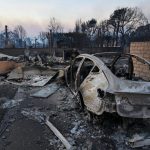Mike Hussey, who was diagnosed with COVID-19, is also set to return on a commercial flight from Doha.It comes just days after a controversial flight ban stopping arrivals from India was lifted from May 15.Passengers can now return to Australia via Doha, with Qatar Airways running flights from major Indian cities to the Qatari capital. One passenger, an Australian temporary visa holder named ‘Anjana R’, took to social media from Doha before boarding a flight to Brisbane. She had flown from the Indian city of Chennai to Doha, she wrote, and was waiting for her flight to Australia to depart. It comes as at least three passengers who were booted off the first rescue flight for Australians stranded in India have now reportedly tested negative for COVID-19.The passengers initially tested positive for coronavirus, although it was understood they had no symptoms. After seeing their own COVID tests, at least three were negative for the virus. Questions are now being asked about the accuracy of the testing program, set up by Federal Government and Qantas The first repatriation flight arrived in Darwin this weekend, with only 78 of the planned 150 people on-board.Those who were refused entry to the flight had either returned positive tests or were deemed close contacts.A Qantas spokesman said the airline had “have reiterated to our diagnostic agency that they must ensure that any laboratory they use has all current and appropriate accreditations”.She said they were investigating if the diagnostic agency used another local laboratory for the pre-departure tests.“We continue to work with DFAT to ensure the process is working as it should,” she said.“The reason we went to India was to bring home as many Australians as possible. Together with DFAT all the protocols put in place were designed to minimise the risk of importing the virus and maximise the safety of everyone on board.”Treasurer Josh Frydenberg was questioned about the issue during a press conference in Melbourne on Sunday.“There are more flights that will be coming from India – we have to follow medical advice,” Frydenberg said.But Opposition leader Anthony Albanese blasted the Federal Government, saying it needed to do more to bring Australians stranded overseas home. “I feel that the Australians in India are very frustrated at the moment,” Albanese said.“They are distressed. I had a zoom call with many of our citizens, along with Penny Wong and Michelle Rowland on Friday.“The citizens there, my heart goes out to them. And of course while they are in India, they are exposed to real health concerns because of the outbreak there.”RETURNING HOMEThe first repatriation flight from India since they were banned by Prime Minister Scott Morrison touched down in Darwin on Saturday.QF112 touched down at Darwin’s Royal Australian Air Force airport ahead of schedule, shortly after 9am EST. A spokesman for the Northern Territory government confirmed there were 78 passengers on the plane from New Delhi.Despite the Qantas plane having capacity for 150 people, 72 passengers were turned away after 48 tested positive for COVID-19 and 24 were identified as close contacts. All passengers were required to return negative PCR and rapid antigen tests before boarding the flight. Australia’s high commissioner to India Barry O’Farrell said the news of so many travellers being unable to fly was disappointing. “My team has worked hard across India to get them bookings on this flight because they are vulnerable,” Mr O’Farrell told the ABC.“Regrettably those people will have to return home [in India] and deal with the COVID that they have, or continue to isolate to prove that they don’t have COVID,” he said. Five buses departed the RAAF base for Howard Springs with many of the seats vacant. Each of the buses had an NT Police escort. A number of returned travellers on the bus waved to media and were seen wearing face masks and face shields while being transported to the facility on the outskirts of Darwin. On Friday, the flight from Australia to India carried ventilators, oxygen and other essential medical supplies to aid the ongoing crisis in India, where COVID-19 has already killed hundreds of thousands of people and continues to spread throughout the community. 70 TRAVELLERS MISS FLIGHTMore than 70 Australians missed the first evacuation flight out of New Delhi after 42 tested positive for COVID-19.Another 31 are deemed close contacts and were also banned from the rescue flight. It is understood authorities were scrambling to find other people to join the flight, which had been booked to accommodate 150 Australians.The government’s National Security Committee signed off on a plan to bring stranded Australians home from India starting May 15.Those who registered with the Department of Foreign Affairs and Trade were offered spots on the first flight and on ones departing May 17 and May 22, according to multiple posts on social media. DEADLY CYCLONE HITS INDIAAt least six people have died in torrential rain and winds as virus-hit India braces for a powerful cyclone, officials said Sunday, with more than 150,000 residents set to be evacuated from their homes.Cyclone Tauktae — India’s first major tropical storm this season — is moving northwards in parallel with the country’s western coast, bringing heavy rains, thunderstorms and strong winds to several states, the meteorological department said.It is expected to make land in coastal Gujarat early Tuesday, bringing wind speeds of around 155-165 kilometres per hour gusting up to 185 kilometres per hour, the weather bureau added.Thousands of disaster response personnel had been deployed to the states, while units from the coast guard, navy, army and air force had been placed on standby, Home Minister Amit Shah said in a statement.Four people lost their lives on Saturday as torrential rain and winds battered Karnataka state, the disaster management authority said Sunday.Several towns and villages were flooded and properties damaged, officials added. Two people died in the resort state of Goa, Chief Minister Pramod Sawant said Sunday, adding that power supply had been disrupted while some 200 houses were damaged, roads were blocked and trees uprooted.Two others were reported dead and 23 fishermen were feared missing in Kerala, local media said.More than 150,000 people are set to be evacuated from coastal districts in Gujarat, where the ongoing COVID-19 vaccination rollout will be suspended on Monday and Tuesday, the state government said.NED-3774-Repatriation-flightsINDIA COULD DELAY EASING OF UK RESTRICTIONSEasing restrictions in the UK could be delayed after cases of the Indian variant of COVID-19 have almost tripled in the past week. On May 5, the UK reported 520 cases of the variant. By May 13, it had reached 1313. While the variant remains low in comparison to the most common variant within the community – the Kent strain – Prime Minister Boris Johnson said there were concerns over how rapidly cases were growing. During a press conference on Thursday, Mr Johnson said the government is “ruling noting out”. “It is a variant of concern, we are anxious about it. At the moment there is a very wide range of scientific opinion about what could happen,” Mr Johnson said.“There is a range of things we could do, we are ruling nothing out.”The UK is currently scheduled to see a lifting of all restrictions on June 21. “At the moment, I can see nothing that dissuades me from thinking we will be able to go ahead on Monday and indeed on June 21, everywhere, but there may be things we have to do locally and we will not hesitate to do them if that is the advice we get,” Mr Johnson said. NEPAL COULD BE THE NEXT INDIANepal is now relying on foreign aid for all its oxygen as a second wave of COVID-19 ravages towns and villages.Harrowing images out of India have dominated international coverage of the pandemic but UNICEF says similar scenes, pictures of mass cremations and bodies on the street, are being replicated in other parts of South Asia, including Nepal and Sri Lanka.The tiny nation of Maldives now has the highest rate of infections per capita in the world while in Nepal there were yesterday alone 9,483 new cases and 225 deaths.UNICEF’s South Asia’s Regional Adviser for Maternal and Child Health Dr Paul Rutter told News Corp Australia there was grave concerns about the latest surge not just in India but in South Asia as a whole.He said alarmingly the region in the past few days now accounted for half of the world’s new cases and “hard earned” global gains in the fight could be reversed if the crisis there was not stopped.“The global gains that have been made are at risk if there are parts of the world where the virus is allowed to circulate and we’ve seen already the risk of further mutations,” Dr Rutter said. “COVID-19 does not respect borders so although that’s not the primary area of concern, we are here for the people of South Asia and the inequitable situation we are seeing across the world, but I think it’s a valid point that the world is not safe until this virus is dealt with everywhere.”In India alone there were now three deaths a minute recorded but similar stories were being seen in nations like Nepal which now has one of the highest viral reproduction rates in the world and where hospitals have been overwhelmed by a critical shortage of oxygen and other kit and medical staff. He said there were reports nurses there were individually having to take care of 20 critical ill patients each.He said vaccines underpin the fight but in India less than 10 per cent of the population have been vaccinate, less than 8 per cent in Nepal less and 5 per cent in Sri Lanka.He said UNICEF was calling on nations which have surplus vaccines to share them.“The time is now,” he said he said in appealing to close the inequity gap. Dr Rutter said the pandemic was also impacting children not just from catching the virus but in lack of general health care, education and child protection concerns as they lose their parents to COVID-19 and are left destitute. It is estimated an additional 2,400 children could die every day from preventable causes over the next six months in South Asia.Meanwhile, Nepal is so short of oxygen canisters, it has asked some 700 climbers currently on Mount Everest and other peaks to bring back their empties instead of abandoning them on mountain slopes.An estimated minimum of 3500 oxygen bottles were carried this season with the empty or half empties ditched in the snow at the end of the expedition which hospitals have now appealed to be returned for refilling for medical use.
Powered by WPeMatico






